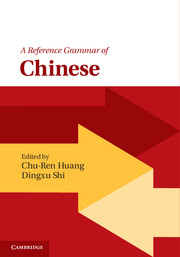Book contents
- Frontmatter
- Dedication
- Contents
- List of figures
- List of tables
- List of contributors
- Preface
- Acknowledgements
- English–Chinese term list
- Chinese–English term list
- 1 Preliminaries
- 2 Syntactic overview
- 3 Lexical word formation
- 4 Verbs and verb phrases
- 5 Aspectual system
- 6 Negation
- 7 Classifiers
- 8 Nouns and nominal phrases
- 9 Relative constructions
- 10 Adjectives and adjective phrases
- 11 Comparison
- 12 Adverbs
- 13 Prepositions and preposition phrases
- 14 Sentence types
- 15 Major non-canonical clause types: ba and bei
- 16 Deixis and anaphora
- 17 Information structure
- Appendix: Punctuation
- Bibliography
- Index
7 - Classifiers
Published online by Cambridge University Press: 05 March 2016
- Frontmatter
- Dedication
- Contents
- List of figures
- List of tables
- List of contributors
- Preface
- Acknowledgements
- English–Chinese term list
- Chinese–English term list
- 1 Preliminaries
- 2 Syntactic overview
- 3 Lexical word formation
- 4 Verbs and verb phrases
- 5 Aspectual system
- 6 Negation
- 7 Classifiers
- 8 Nouns and nominal phrases
- 9 Relative constructions
- 10 Adjectives and adjective phrases
- 11 Comparison
- 12 Adverbs
- 13 Prepositions and preposition phrases
- 14 Sentence types
- 15 Major non-canonical clause types: ba and bei
- 16 Deixis and anaphora
- 17 Information structure
- Appendix: Punctuation
- Bibliography
- Index
Summary
This chapter describes classifiers, which consist of sortal classifiers and measure words and are found in noun phrases in Chinese. The three semantic classes of sortal classifiers are individual classifiers, event classifiers, and kind classifiers; and the three semantic classes of measure words are container measure words, approximation measure words, and standard measure words. The classifier system is an important characteristic of Chinese. In this chapter, we will give examples of the most commonly used classifiers and discuss how sortal classifiers may coerce different interpretations from nouns.
Definition of classifiers
Classifiers [CL] in this chapter refer to the morphosyntactic category serving the semantic function of marking noun classes. Chinese has a particularly rich nominal classifier system that requires classifiers to occur in a noun phrase using the following construction:
Determiner (Det)/Number (Num)/Quantifier (Q) – Classifier (CL) – Noun (N)
A noun may select only one classifier (either a sortal classifier or a measure word) in any given context. Thus, sortal classifiers and measure words occur in complementary distribution and cannot co-occur. In what follows, we will first introduce a set of criteria to establish and differentiate the different types of classifiers based on their semantic functions and syntactic distribution.
Note that “classifier,” as well as its corresponding Chinese term 量词 liang4ci2 (literally, measure + word), is often used to refer to both the broader grammatical category given above and its narrower subcategory with the specific semantic function of identifying a class. We will maintain the convention of using “classifier” (or 量词 liang4ci2) exclusively to refer to the grammatical category and will use the unambiguous terms of “sortal classifier” and “measure word” to refer to its subcategories.
Semantic properties of classifiers
Taxonomy of classifiers according to their semantic functions
Sortal classifiers (often referred to as 分类词 fen1lei4ci2 ‘classifier’ in Chinese literature) are usually considered the prototypical type of classifier, as they linguistically mark conventionalized conceptual noun classes. Sortal classifier selection may be motivated by the inherent properties of the noun, which are often conceptually salient and intuitive, as 只 zhi1 selects animals, whereas 张 zhang1 selects thin, broad objects. Measure words, on the other hand, are not typical classifiers, as they do not directly refer to noun classes.
- Type
- Chapter
- Information
- A Reference Grammar of Chinese , pp. 169 - 198Publisher: Cambridge University PressPrint publication year: 2016
- 14
- Cited by

